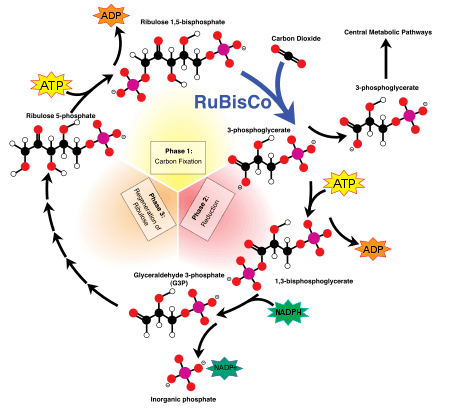Ribulose 1,5-bisphosphate
 | |
 | |
| Names | |
|---|---|
| IUPAC name
1,5-Di-O-phosphono-D-ribulose | |
| Other names
Ribulose 1,5-diphosphate | |
| Identifiers | |
3D model (JSmol) |
|
| ChEBI | |
| ChemSpider | |
| |
| |
| Properties | |
| C5H12O11P2 | |
| Molar mass | 310.09 g·mol−1 |
Except where otherwise noted, data are given for materials in their standard state (at 25 °C [77 °F], 100 kPa). | |
| Infobox references | |
Ribulose 1,5-bisphosphate (RuBP) is an organic substance that is involved in photosynthesis. It is a colourless anion, a double phosphate ester of the ketopentose (ketone-containing sugar with five carbon atoms) called ribulose. Salts of RuBP can be isolated, but its crucial biological function happens in solution.[1] To simplify the presentation, the image in the above table depicts the acid form of this anion.
Role in photosynthesis

The enzyme ribulose bisphosphate carboxylase oxygenase (RuBisCO) catalyzes the reaction between RuBP and carbon dioxide. The product is the highly unstable six-carbon intermediate known as 3-keto-2-carboxyarabinitol 1,5-bisphosphate. This six-carbon intermediate decays virtually instantaneously into two molecules of 3-phosphoglycerate (3-PGA) (see figure). RuBisCO also catalyzes RuBP with oxygen (O
2) in a process called photorespiration, a process that is more prevalent at high temperatures. During photorespiration RuBP combines with O
2 to become 3-PGA + phosphoglycolic acid. In the Calvin cycle, RuBP is a product of the phosphorylation of ribulose-5-phosphate by ATP.